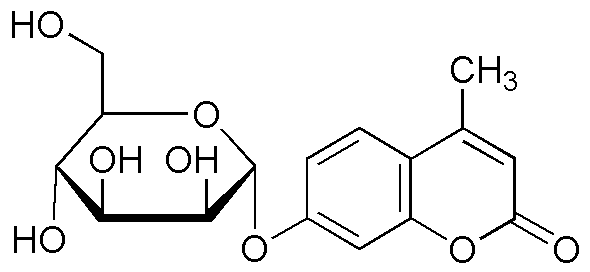4-Methylumbelliferyl-a-D-mannopyranoside is widely utilized in research focused on:
- Enzyme Activity Assays: This compound serves as a substrate for various glycosidases, allowing researchers to measure enzyme activity in biochemical assays effectively.
- Fluorescent Labeling: Its fluorescent properties make it ideal for labeling carbohydrates in biological samples, aiding in the visualization of cellular processes under a fluorescence microscope.
- Carbohydrate Metabolism Studies: It is used in studies investigating carbohydrate metabolism, helping to understand how sugars are processed in different organisms.
- Diagnostics: In clinical laboratories, it can be applied in diagnostic tests to detect specific enzymes related to metabolic disorders, providing critical information for patient care.
- Research in Glycobiology: This compound plays a significant role in glycobiology research, helping scientists explore the structure and function of carbohydrates in biological systems.
General Information
Properties
Safety and Regulations
Applications
4-Methylumbelliferyl-a-D-mannopyranoside is widely utilized in research focused on:
- Enzyme Activity Assays: This compound serves as a substrate for various glycosidases, allowing researchers to measure enzyme activity in biochemical assays effectively.
- Fluorescent Labeling: Its fluorescent properties make it ideal for labeling carbohydrates in biological samples, aiding in the visualization of cellular processes under a fluorescence microscope.
- Carbohydrate Metabolism Studies: It is used in studies investigating carbohydrate metabolism, helping to understand how sugars are processed in different organisms.
- Diagnostics: In clinical laboratories, it can be applied in diagnostic tests to detect specific enzymes related to metabolic disorders, providing critical information for patient care.
- Research in Glycobiology: This compound plays a significant role in glycobiology research, helping scientists explore the structure and function of carbohydrates in biological systems.
Documents
Safety Data Sheets (SDS)
The SDS provides comprehensive safety information on handling, storage, and disposal of the product.
Product Specification (PS)
The PS provides a comprehensive breakdown of the product’s properties, including chemical composition, physical state, purity, and storage requirements. It also details acceptable quality ranges and the product's intended applications.
Certificates of Analysis (COA)
Search for Certificates of Analysis (COA) by entering the products Lot Number. Lot and Batch Numbers can be found on a product’s label following the words ‘Lot’ or ‘Batch’.
*Catalog Number
*Lot Number
Certificates Of Origin (COO)
This COO confirms the country where the product was manufactured, and also details the materials and components used in it and whether it is derived from natural, synthetic, or other specific sources. This certificate may be required for customs, trade, and regulatory compliance.
*Catalog Number
*Lot Number
Safety Data Sheets (SDS)
The SDS provides comprehensive safety information on handling, storage, and disposal of the product.
DownloadProduct Specification (PS)
The PS provides a comprehensive breakdown of the product’s properties, including chemical composition, physical state, purity, and storage requirements. It also details acceptable quality ranges and the product's intended applications.
DownloadCertificates of Analysis (COA)
Search for Certificates of Analysis (COA) by entering the products Lot Number. Lot and Batch Numbers can be found on a product’s label following the words ‘Lot’ or ‘Batch’.
*Catalog Number
*Lot Number
Certificates Of Origin (COO)
This COO confirms the country where the product was manufactured, and also details the materials and components used in it and whether it is derived from natural, synthetic, or other specific sources. This certificate may be required for customs, trade, and regulatory compliance.


